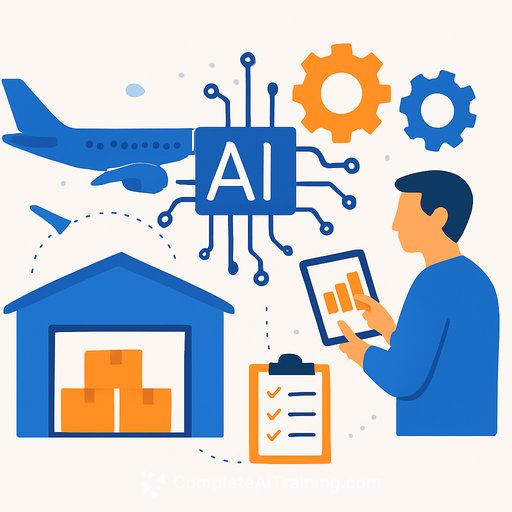AI Is Changing E-Commerce: Faster Conversions, Faster Growth, New Operational Pressure
AI moved past chatbots and basic recommendations. It now steers discovery, compresses the funnel, and shortens the path to checkout. In an August 2025 survey by Passport and Drive Research, 84% of brands reported using AI in key customer-facing areas like marketing, personalization, and support.
That front-end lift is creating a back-end bottleneck. Fulfillment, compliance, and delivery are feeling the squeeze. If demand speeds up but operations don't, customer experience breaks where it matters most-post-purchase.
What's Changing in the Buyer Journey
Personalization has moved from "you might like this" to intent prediction. Adobe expects a 520% jump in AI-assisted shopping this holiday season, which means more orders and higher volatility for your teams.
Discovery, comparison, and checkout are blending into one flow. Dynamic pricing, real-time merchandising, and conversational shopping (think "Find leather boots under $100" and pay in the same thread) are setting a new norm. Google and Meta tried native checkouts with limited traction; TikTok Shop is a standout, clearing about $9B GMV in the U.S. in 2024 and roughly $33B worldwide.
ChatGPT's Instant Checkout is a different angle: commerce through dialogue rather than stuffing checkout into feeds or search. If it sticks, support and operations will see faster spikes, fewer signals before orders hit, and higher expectations for status clarity and speed.
The Operational Gap
Passport's data shows most leaders still lag on the back end. Roughly a third use AI for inventory, fewer for compliance or cross-border. Front-end gains are exposing old fulfillment pain: fluctuating volumes, tighter delivery promises, and thorny global rules.
Every frictionless checkout creates a clock. Every predictive promo injects uncertainty into pick/pack capacity and stock placement. Without alignment, CS queues grow, exceptions rise, and margins erode.
What Support and Operations Need Now
Core Moves for the Next 90 Days
- Instrument the pipeline: Link marketing calendars, promo plans, and model-driven offers to capacity dashboards. Alert on spike thresholds before they trigger stockouts or missed SLAs.
- Tighten address and duty accuracy: Turn on address validation and pre-calculate landed costs (DDP where feasible) to reduce holds, returns, and "surprise at the door" CS contacts.
- Exception triage: Standardize reason codes (failed delivery, customs hold, wrong HS code, label error). Auto-route to the right team and set time-bound SLAs.
- Return flow sanity: Offer localized labels, clear RMA steps, and fast refunds once scans hit. Shorten return-to-restock time to protect availability.
- Capacity planning: Model "promo + AI boost" scenarios by SKU and region. Pre-stage inventory, flex pick/pack labor, and align carrier pickups before campaigns go live.
- Agent enablement: Surface order status, shipment events, and fees inside the ticket. Provide macros for common AI-promo issues (wrong size surges, address typos, doubled orders).
- Compliance readiness: Maintain HS code accuracy, monitor de minimis thresholds, and decide DDP vs DAP per lane. Small policy tweaks can cut delays and CS friction.
Global Selling: Make It Work Before You Scale It
In a February 2025 survey of 100 U.S. leaders, 91% said international is a strong revenue lever, yet few feel ready for taxes, customs, and cross-border logistics. Growth is easy to turn on; compliance and delivery precision are where it stalls.
- De minimis and import rules: Track limits and documentation by country. For the U.S., see CBP's guidance. For the EU, review IOSS requirements.
- Landed cost transparency: Show duties/taxes pre-checkout. Choose DDP to reduce doorstep surprises and carrier storage fees.
- Localized experience: Auto-translate product pages and support templates, reflect local pricing, and offer local payment and pickup options.
- Returns across borders: Define where items go back, who pays, and how refunds trigger. Communicate this clearly in the cart and confirmation email.
Playbook: 30/60/90 for Support and Ops Leaders
First 30 Days
- Build a shared "demand → capacity" view (promos, AI offers, forecast, labor, carriers).
- Enable address validation, shipment event webhooks, and exception reason codes.
- Audit HS codes, DDP/DAP settings, and tax calculations on top markets.
- Stand up a live "promise vs actual" dashboard for order cycle time and on-time rate.
Next 60 Days
- Introduce a rules engine for shipping method selection by SLA, region, and cart value.
- Pre-calculate landed cost in cart; require harmonized codes on new SKUs.
- Auto-escalate customs holds after N hours and notify customers proactively.
- Upgrade the knowledge base with short, regionalized answers and agent macros.
By 90 Days
- Scenario test peak weeks with "promo + AI uplift" assumptions; lock staffing and carrier plans.
- Add multi-node fulfillment or forward stocking for fast movers in key regions.
- Optimize returns flow (refund on first scan, automated restock updates).
- Quarterly compliance review across top lanes; track duty accuracy and clearance delays.
Metrics That Matter
- Delivery: Order cycle time, promised vs actual, on-time delivery %, exceptions per 1,000 orders.
- Inventory: Stockouts, backorder rate, MAPE by SKU/region, return-to-restock time.
- Compliance: Clearance delay rate, duty/tax accuracy, rework due to HS or value errors.
- Support: First-contact resolution, average handle time, post-contact CSAT, refund/chargeback rate.
- Finance: Cost per order and margin after logistics and duties.
Tech and Team: Where Intelligence Meets Delivery
The brands that win connect predictions at the point of sale with precise execution in pick, pack, ship, and tax. That takes both systems and people.
- Stack basics: OMS ↔ WMS ↔ TMS with real-time inventory, event webhooks, and an address/duty engine.
- Automation with guardrails: Shipping rules, fraud checks, and exception routing with clear human overrides.
- Agent workflow: Unified order timeline, shipment details, landed cost breakdown, and one-click updates.
- Accountability: Owner per metric, weekly review of misses, and a rollback plan for risky automations.
Skill Gaps Are the Bottleneck
Nearly half of leaders cite a lack of expertise as their biggest blocker. Tools won't fix that by themselves. Pair your tech roadmap with targeted upskilling and external specialists who live and breathe global shipping, tax, and compliance.
If your team needs a fast way to level up on AI for support and operations, browse practical programs by role at Complete AI Training.
Bottom Line
AI is pulling demand forward. Your edge comes from delivery that keeps pace. Tie marketing and checkout signals to inventory, carriers, and compliance decisions in near-real time. Make the promise clear, keep it, and make recovery effortless when things slip.
Speed converts. Precision retains. Do both.
Your membership also unlocks:










